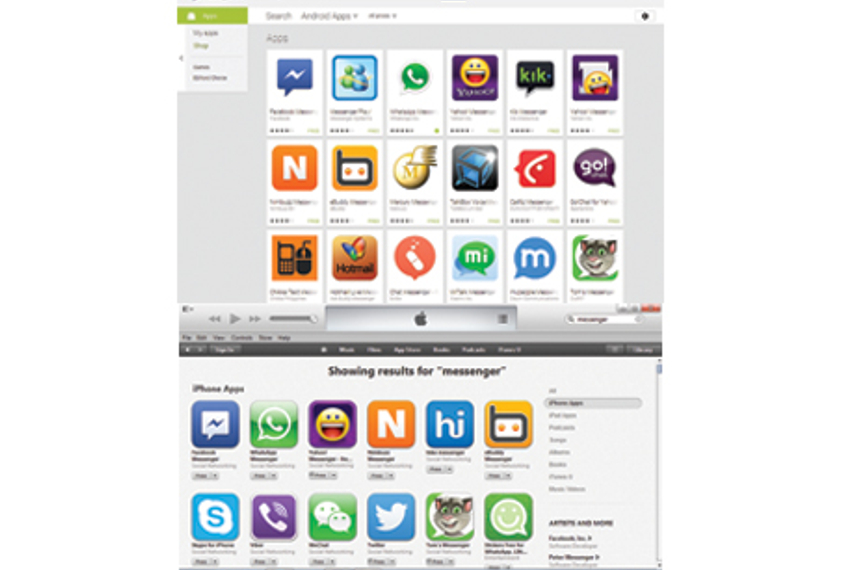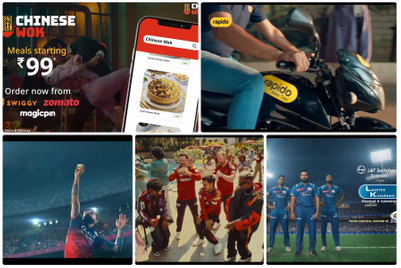
Free messaging’ services seem to have replaced the ‘short messaging service’ as smartphone users are being pampered with an abundance of options.
Brands like Hungama, PVR Cinemas, Big Bazaar, Santa Banta and Café Coffee Day have taken note. They are among brands using the medium to engage consumers directly through ‘official accounts’ offered on one such messaging service – Wechat. The messenger, which surpassed 300 million users globally this May, sees opportunity for more brands to join the wagon. While it may be a while before in-app advertising and ‘official accounts’ become the norm across messenger services, the offtake of such alternate modes of instant messaging has brands watching the space with keen interest. Besides brands, consumers are willing to pay too, for things like stickers, to covey emotions better. A ‘value add’, according to some service providers.
Blackberry had planned to roll out its messenger service on 21 September 2013 across the iOS and Android platforms. The launch was much anticipated by users who’d moved away from the BlackBerry hardware to other platforms. But the launch never took place - it was rolled out on the App Store for a while, but taken off. Those who were disappointed weren’t left without options. They had their cross-platform messenger services like Wechat, Whatsapp, Line, Hike, Facebook, Viber and more to turn to.
The idea is not to highlight the fact that BBM delayed its roll out – what is significant is the fact that Blackberry is looking to straddle platforms with its messenger service. And the fact that there’s an abundance of choice already available to users seeking chat platforms.
While each application seems to be promoting itself with a different USP, their features seem to be more or less the same.
Wechat claims that its messenger was the most downloaded application in India on iOS’ App Store and Google’s Play Store between May and July 2013. Katie Lee, assistant general manager of international PR, Wechat, reasons, “Local customisations like Hindi language support, emoticons of popular Indian young celebrities like Parineeti Chopra and Varun Dhawan and associations with recent Bollywood movies have helped Wechat create a strong recall within users in India. That’s what took us to the number one rank on Google’s Play Store and iOS App store.”
According to Facebook, its chat messenger’s differentiator is its personalisation. Kevin D'Souza, country growth manager, Facebook India, says, “No matter what you're doing or where you are, you can reach your friends on Facebook - and you're reaching your friend, not a phone number or a screen name so it's personal, real and intimate. With Facebook messenger, Facebook is not trying to replace face to face communication, but are focused on helping people bring their conversations to life so they can better express themselves. Our focus is on building the best experiences to help people connect.”
To build these experiences, the brand tests and experiments with different features to find what users want the most. Building features for the Messenger app has been a big part of this testing and learning process, explains D’Souza. For the 82 million Facebook users in India (62 million accessing through mobile), messenger offers an option to stay connected. “Chatting is one aspect of social media that is very highly used. We believe that with the new additional features such as Chat heads and stickers, users are just one tap away from chatting with his friends will get more options to make their chats more interesting and fun,” he adds.
On the move to be made available on iOS and Android, Varghese Thomas, director, corporate communications - India and SAARC Region, Blackberry, says, “This is an opportunity for BBM to become a more competitive player in the rapidly growing private social network space. With its clean, simple experience built around mobile, real time engagement, BBM is well-placed to drive this industry forward. BBM is trusted, immediate and gives control of personal information back to the user. This focus on privacy and providing an engaging, collaborative experience with a personal social network will set BBM apart. We feel that the opportunity to bring the best private social network to Android and iPhone users has never been better.”
As mentioned earlier, all the apps are free to use. While Whatsapp charges after one year of free use, a lot of users have found ways to evade the cost. So, how are these apps looking to monetise?
Wechat’s Lee says, “Going forward, we can expect more and more interactivity on the social messaging applications. Interactivity, not only in terms of peer-to-peer, but we will also see more and more brands using social messaging applications to enhance interactivity with their consumers.”
On the opportunity to monetise consumers, she adds, “We do not plan to charge individuals to use Wechat main features and will continue to develop and deliver fun and easy-to-use features to enhance users’ social experience through this innovative mobile social communication application. Currently, Wechat is in the early stage of internationalisation. We will be soon coming out with innovative and interesting features for users that will be paid for. With Wechat 5.0, we have launched the sticker shop where users get a choice of downloading quirky stickers and paying for stickers via the online platform. The success of Wechat really boils down to social experience and value we brought to users.”
Another messaging service, Line, follows a similar route with its ‘Paid Stickers’ (B2C), ‘Game in-app purchases’ (B2C) and ‘Official Account and Sponsored Stickers’ (B2B). A spokesperson from the company elaborates, “In addition to basic Line character stickers provided for free, Paid Stickers are also available for download at a ‘Sticker Shop’. According to App Annie, an app store analytics and market intelligence for the global app economy, in May 2013, Line was ranked the on top of the grossing apps on Google Play and number two on iTunes App Store (excluding games).”
In addition to this, monetisation is also helped by the 36 game titles that are available to download through ‘Line Game’. The company claims that till June 2013, it had achieved 150 million downloads since its launch in July 2012.
Its B2B sales come through ‘Offical Account and Sponsored Stickers’. Partner brands can open their own official brand accounts in Line. By ‘befriending’ brand accounts, users can avail of discount offers and coupons.
“Through a number of campaigns, brand accounts are proven to be more effective than conventional internet advertising methods in terms of reach, engagement, and other important marketing factors. Also, ‘Sponsored Stickers’ are effective marketing tools for promoting products and raising brand awareness. ‘Sponsored Stickers’ are distributed for free and very actively used by users. Depending on market situations or user numbers in each country, we prioritise which one among those to focus on. Regarding the Indian market, since majority of mobile users prefer prepaid than postpaid services, we assume B2B model would be more suitable for the market. However, we would like to cultivate a culture where users buy something in Line through providing India-localised stickers,” the spokesperson adds.

Launched: 2009
Active global users: 300 million
Cost: Free for the first year (0.99 dollars to download thereafter)
Blackberry
Launched: Early 2006
Active global users: 60 million (only across Blackberry hardware)
Cost: Free

Launched: 2011
Active users: 300 million +
Cost: Free
.jpg&%3bh=90&%3bw=80&%3bc=0)
Line
Launched: 2011 in Japan
Active users: 250 million
Cost: Free

Launched: August 2011
Cost: Free
The article appeared in the issue of Campaign India dated 4 October, 2013


.jpg&h=334&w=500&q=100&v=20250320&c=1)
.jpg&h=334&w=500&q=100&v=20250320&c=1)


.jpg&h=334&w=500&q=100&v=20250320&c=1)

.jpg&h=334&w=500&q=100&v=20250320&c=1)

.jpg&h=334&w=500&q=100&v=20250320&c=1)



.png&h=268&w=401&q=100&v=20250320&c=1)





